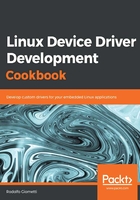
Installing the Development System
In this chapter, we will present and set up our working platform. In fact, even if we write and then test our own device drivers on our working PC, it is recommended to use a second device to test the code. This is because we're going to work in the kernel space where even a little bug can cause severe malfunctioning! Also, using a platform where several kinds of peripherals are available allows us to test a large variety of devices that are not always available on a PC. Of course, you are free to use your own system to write and test your drivers but, in this case, you should take care of the modifications needed to fit your board specifications.
In this book, I'm going to use the Marvell ESPRESSObin system, which is a powerful Advanced RISC Machines (ARM) 64-bit machine with a lot of interesting features. In the following figure, you can see the ESPRESSObin alongside a credit card and can gain an idea about the real dimensions of the board:

My board is the v5 release of ESPRESSObin while the latest version at the time of writing (announced on September 2018) is v7, so the reader should be able to get this new release by the time this book is published. The new ESPRESSObin v7 will feature 1GB DDR4 and 2GB DDR4 configurations (while v5 has DDR3 RAM chips), and a new 1.2GHz chipset will replace the currently sold configurations, which sports 800MHz and 1GHz CPU frequency limits. Even by taking a quick look at the new board layout, we see that a single SATA connector has taken the place of the existing two-pieces combination of SATA power and interface, the LED layout is now rearranged in a row, and an on-board eMMC is now in place. Moreover, this new revision will ship with an optional 802.11ac + Bluetooth 4.2 mini PCIe Wi-Fi card, which is sold separately.
In order to test our new drivers, we will cover the following recipes in this first chapter:
- Setting up the host machine
- Working with the serial console
- Configuring and building the kernel
- Setting up the target machine
- Doing native compiling on foreign hardware